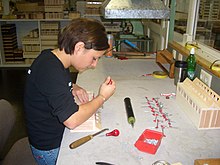Bass mechanics
The bass mechanics are the connecting elements of the bass and chord buttons and the corresponding bass and chord keys in an accordion .
In the bass of the accordion there is no direct fixed connection between button and flap as in the treble, but rather the bass mechanics, consisting of bass and chord work (sometimes also called mechanics) are used.
In order to explain this a little more has to be elaborated:
With the bass, the individual tones are used multiple times and sound with several buttons - in contrast to the treble, where exactly one tone and one key always belong together.
For an accordion with a 120 standard bass, you would need 20 keys for the basic bass, 20 for the third bass and 240 for the chords if connected directly. That makes a total of 280 bass and chord keys. It is understandable that this is impossible if the instrument is to remain manageable.
The solution to the problem is to limit yourself to the 12 notes of the chromatic scale for both the bass and the chords. That means, you get by with 12 tones for the bass and 12 tones for the chords, i.e. a total of 24 tones including keys. With these all basses can be played, as well as any combination of all chords. The task of the bass and chord works is now to transfer the movement of the playing buttons to the bass and chord keys so that they open.
Layout and function
The bass and chord keys are attached to the clavis levers, which in turn are mounted on an axis on the bass panel. The mechanism consists of the chord buttons, button sliders, driving pins, wave pins, bass and chord waves and the finger sliders.
A so-called finger slider belongs to every bass and chord key. The bass finger slider has two U-shaped hooks at its end, the chord finger slider only one. In doing so, they press the clavis levers of the bass and chord keys or only those of the chord key. A driving pin is mounted on the finger slide and rests on the shaft pin of the shaft belonging to the tone. There are a total of 24 waves, 12 bass waves and 12 chord waves. Depending on the tone, four or five wave pins are attached to the bass waves, one for the finger slide and one for each button slide that rests against the wave pin with a driver pin. For example, there are three C-bass buttons, two in the third bass row and one in the basic bass row. The bass button is mounted on the button slide. When the bass button is pressed, the finger slide also moves. This rotates the bass wave through the driver and shaft pin, which in turn moves the finger slide via the shaft and driver pin. This presses with one hook on the clavis lever of the bass key and with the other against that of the chord key, whereby both keys stand out from the tone holes. This has the effect: when playing the bass, the bass and chord tone sound in two to five courses, depending on how the registration is performed (e.g. contra C, C, c, c ', c' ').
Significantly more shaft pins are mounted on the chord waves than on the bass waves, as the individual tones are used more frequently (example: with a 120 bass, the tone c is required 17 times in the combination of 80 chords, the tone e 19 times). On the button slide of the chord button three driving pins are attached, which move the three chord waves of the notes contained in the chord. These in turn move the chord finger sliders, also via shaft pins and driver pins. However, these only have one hook and only open the chord keys by pressing the clavis lever.
Vocational training as a hand-drawn instrument maker
According to § 9 of the regulation on vocational training to become a hand-drawn instrument maker , the final / journeyman's examination in Germany extends to the skills and knowledge listed in the annex as well as the subject matter taught in vocational school lessons, insofar as it is essential for vocational training.
When making the test piece, components of a hand traction instrument should be manufactured and at least four of the tasks listed in § 9 should be carried out, including assembling and adjusting the bass mechanics in the vector group.

